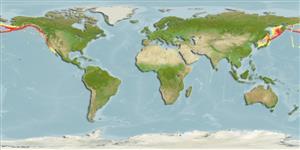Actinopterygii (ray-finned fishes) >
Scorpaeniformes (Scorpionfishes and flatheads) >
Sebastidae (Rockfishes, rockcods and thornyheads) > Sebastolobinae
Etymology: Sebastolobus: Greek, sebastes = august, venerable + Greek, lobos = lobe (Ref. 45335); alascanus: Species name after Alaska, the type locality (Ref. 27436). More on author: Bean.
Environment / Climate / Range
Ecology
Marine; demersal; depth range 17 - 1600 m (Ref. 50550), usually 91 - ? m (Ref. 2850). Temperate, preferred 5°C (Ref. 107945)
North Pacific: Sea of Okhotsk north to the Navarin Canyon in the Bering Sea and from Stalemate Bank and Ulm Plateau in the Aleutian Islands southeast to Cedros Island, Baja California, Mexico. Reported from Japan (Ref. 559).
Length at first maturity / Size / Weight / Age
Maturity: Lm 22.0 range ? - ? cm
Max length : 80.0 cm SL male/unsexed; (Ref. 559); max. published weight: 9.0 kg (Ref. 56527); max. reported age: 100 years (Ref. 90032)
Dorsal
spines
(total): 15 - 17;
Dorsal
soft rays
(total): 8-9;
Anal
spines: 3;
Anal
soft rays: 4 - 5. Head spines very strong - nasal, preocular, supraocular, postocular, tympanic, parietal and nuchal spines present, coronal spines absent; large head and elongate body; strong spiny ridge on head; 3rd dorsal spine not much longer than 2nd, 4th or 5th; strong notch on pectoral fin (Ref. 27437). Bright red with some black on fins; gill chamber mostly pale (Ref. 27437). Caudal slightly rounded (Ref. 6885).
Very common on soft bottoms (Ref. 2850). Oviparous (Ref. 205). Eggs are extruded in floating gelatinous masses (Ref. 31279). Have a thick glandular tissue on posterior margin of fin spines which is believed to be venomous (Ref. 57406). Rarely taken by game fishers (Ref. 27436). Flesh sweeter than that of other rockfishes (Ref. 27436).
Unlike other representatives of this group, this species has internal fertilization Oviparous (Ref. 6885). Females possess specialized ovarian structures including stalk-like ovigerous lamellae and secretory epithelia (Ref. 32832).
Eschmeyer, W.N., E.S. Herald and H. Hammann, 1983. A field guide to Pacific coast fishes of North America. Boston (MA, USA): Houghton Mifflin Company. xii+336 p. (Ref. 2850)
IUCN Red List Status (Ref. 115185)
CITES (Ref. 94142)
Not Evaluated
Human uses
Fisheries: minor commercial
More information
ReferencesAquacultureAquaculture profileStrainsGeneticsAllele frequenciesHeritabilityDiseasesProcessingMass conversion
Tools
Special reports
Download XML
Internet sources
Estimates of some properties based on models
Phylogenetic diversity index (Ref.
82805): PD
50 = 0.6250 [Uniqueness, from 0.5 = low to 2.0 = high].
Bayesian length-weight: a=0.00891 (0.00388 - 0.02045), b=3.10 (2.89 - 3.31), in cm Total Length, based on LWR estimates for this (Sub)family-body shape (Ref.
93245).
Trophic Level (Ref.
69278): 3.6 ±0.3 se; Based on diet studies.
Resilience (Ref.
69278): Very Low, minimum population doubling time more than 14 years (tmax> 100 (validated age: 62 yrs); tm= 13; Fec > 10,000).
Prior r = 0.1, 2 SD range = 0.02 - 0.58, log(r) = -2.3, SD log(r) = 0.87, Based on: 1 K, 1 tgen, 1 tmax, 2 Fec records
Vulnerability (Ref.
59153): High to very high vulnerability (70 of 100) .
